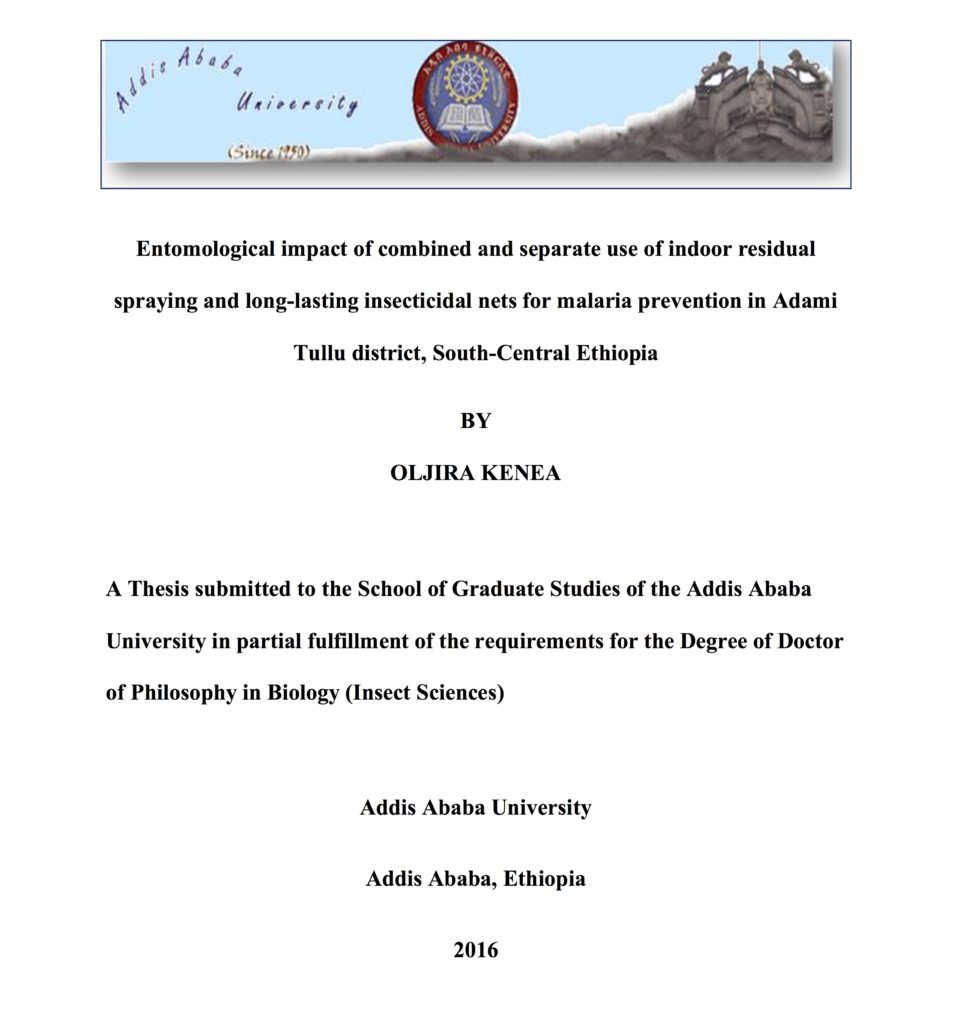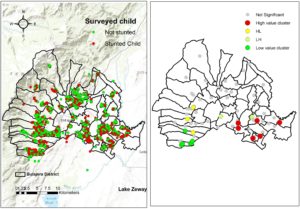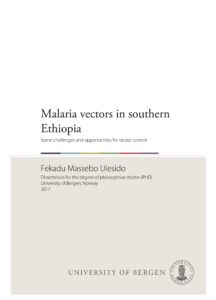
Kena, O. 2017. Entomological impact of combined and separate use of indoor residual spraying and long-lasting insecticidal nets for malaria prevention in Adami Tullu district, South-Central Ethiopia. PhD thesis. Addis Ababa University.
Indoor residual spraying (IRS) and long-lasting insecticidal nets (LLINs) are the key frontline malaria prevention interventions in Ethiopia. Both target Anopheles arabiensis, the sole primary malaria vector. Universal coverage of both interventions has been promoted and there is a growing demand in combination of interventions for malaria control and elimination. However, available evidence is contradictory wether the combined intervention is better than either IRS or LLINs alone. To investigate whether IRS and LLINs combination provides added protective impact on An. arabiensis compared to either IRS or LLINs alone, a cluster randomized controlled trial was carried out in Adami Tullu district, south-central Ethiopia. Villages were randomly allocated to four study arms: IRS+LLINs, IRS, LLINs, and control. All households in the IRS+LLINs and LLINs arms were provided with LLINs (PermaNet 2.0) free of charge. Households in the IRS+LLINs and IRS arms were applied with propoxur before the main malaria transmission season in 2014 and 2015. Adult mosquitoes were collected in randomly selected villages in each arm using CDC light trap catch (LTC) set close to a sleeping person, pyrethrum spray catch (PSC), and artificial pit shelter (PIT), for measuring host-seeking density (HSD), indoor resting density (IRD), and outdoor resting density (ORD) of the anophelines. Human landing catch (HLC) was performed in selected villages to monitor the impact of the interventions on local mosquito biting behaviours (biting location, time and host preference).
Collected anophelines were identified to species by use of standard morphological keys and additional use of molecular methods to separate sibling species of the An. gambiae complex. Enzyme-linked immunosorbent assay (ELISA) was used to detect malaria infections in mosquitoes and the sources of mosquito blood meals. Mean densities were compared using incidence rate ratio (IRR) calculated by negative binomial regression. Parity rate (percentage of parous females) was also determined by ovarial dissection. Human blood index (HBI) was expressed as the proportion of mosquitoes with human blood divided by the total number of blood-fed mosquitoes tested.
A total of 1786 female anophelines of four species (An. arabiensis, An. pharoensis, An. ziemanni and An. funestus s.l.) were collected over two transmission seasons during the intervention period (2014-2015). Anopheles numbers were highest in the control arm (41.3% of total) followed by LLINs (25.4%), IRS (18.0%), and IRS+LLINs (15.8%). In most of the vector parameters estimated, the impact of IRS and LLINs combined and separate interventions were significantly higher in communities that recieved the interventions (in experimental groups) compared with untreated communities (control group). The mean HSD of An. arabiensis in the IRS+LLINs arm was similar to the IRS arm (0.03 vs. 0.03/ house/LTC/night) but lower than the LLINs arm (0.03 vs. 0.10/house/LTC/night, p=0.07) and so was the difference in IRD and ORD between the IRS+LLINs compared to the IRS arm. However, both IRD and ORD of An. arabiensis were higher in LLINs compared to IRS+LLINs (p < 0.001 for indoors). Parity rate of An. arabiensis were similar among the intervention arms. None of the 1786 samples of four species tested by ELISA was positive for P. falciparum and P. vivax CSP infection in all of the study arms. Anopheles arabiensis preferred mainly bovine and human hosts for blood meal sources with high HBI in the LLIN alone. Indoor resting habit of An. arabiensis was less impacted by LLINs alone intervention compared to IRS + LLINs or IRS alone.
In conclusion, the IRS+LLINs and the IRS alone each was similarly most effective against An. arabiensis as compared to the LLINs alone. The IRS+LLINs provided added impact on An. arabiensis compared to LLINs alone. The LLINs alone had poor impact on densities and human biting rates of An. arabiensis in this study setting.
You can download the thesis here: Oljira-Kenea-thesis


 Hagos S, Hailemariam D, WoldeHanna T, Lindtjørn B (2017) Spatial heterogeneity and risk factors for stunting among children under age five in Ethiopia: A Bayesian geo-statistical model.
Hagos S, Hailemariam D, WoldeHanna T, Lindtjørn B (2017) Spatial heterogeneity and risk factors for stunting among children under age five in Ethiopia: A Bayesian geo-statistical model.  On Friday, January 27, Fekadu Massebo defended his PhD thesis at the University of Bergen. This was a good defence with a thorough scientific discussion. For the first time at the University of Bergen, the first and second opponents were African. This is a testimony to the emerging strength of African scientists.
On Friday, January 27, Fekadu Massebo defended his PhD thesis at the University of Bergen. This was a good defence with a thorough scientific discussion. For the first time at the University of Bergen, the first and second opponents were African. This is a testimony to the emerging strength of African scientists.